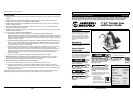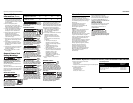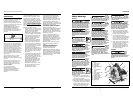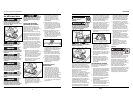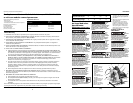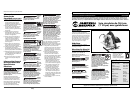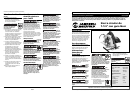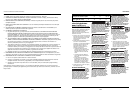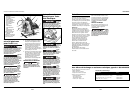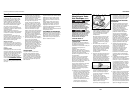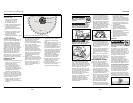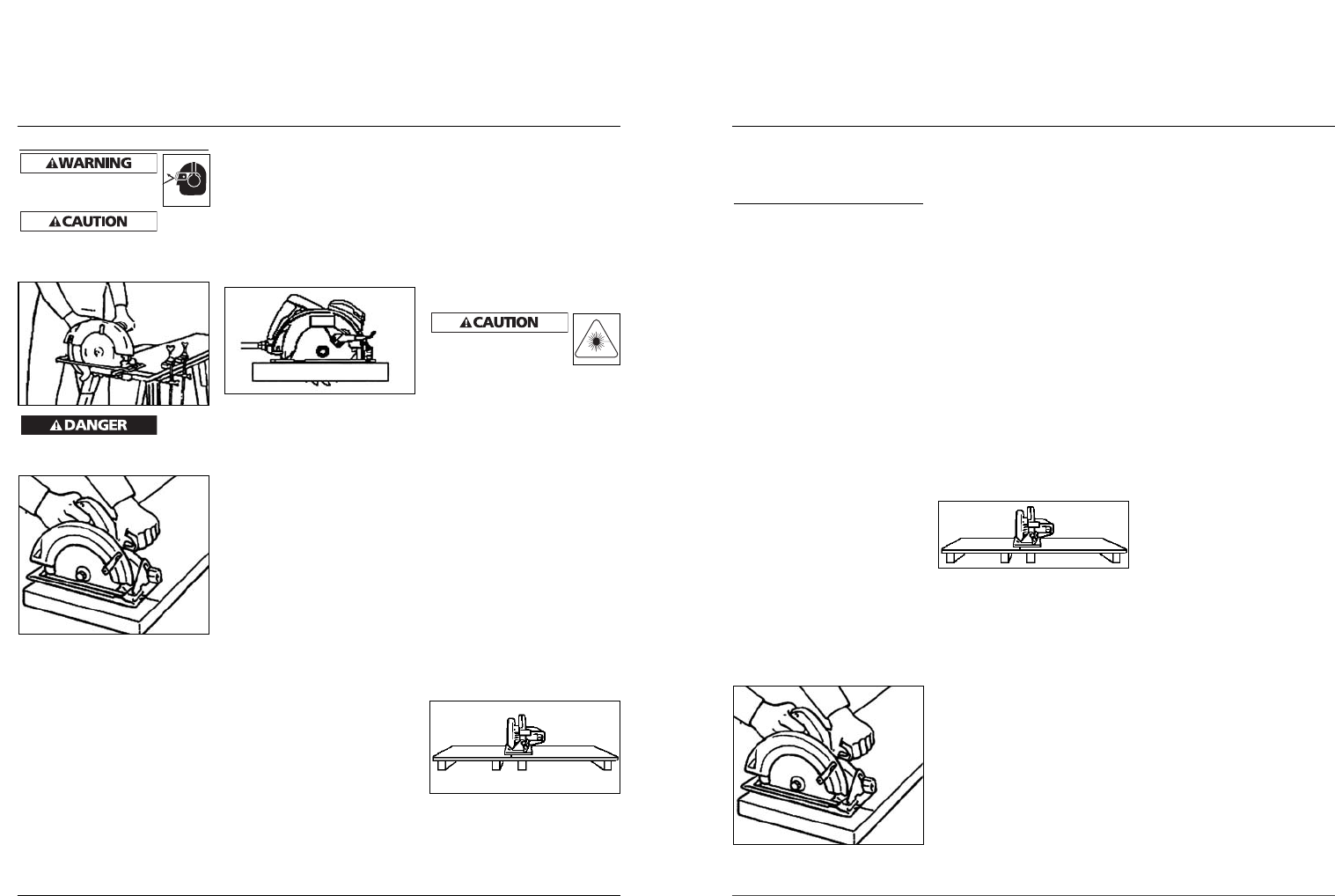
Instrucciones de
Seguridad para Todas
las Sierras Eléctricas
(Continuación)
CAUSAS DEL CONTRAGOLPE Y
PREVENCIÓN POR PARTE DEL
USUARIO:
El contragolpe es una reacción
repentina de una hoja de sierra
mordida, atascada o mal alineada,
provocando que una sierra fuera de
control se levante y salga de la pieza
de trabajo hacia el operador.
Cuando la hoja esté mordida o
atascada firmemente por la entalla
cerrándose, la hoja se para y la
reacción del motor impulsa la unidad
rápidamente hacia el operador.
Si la hoja se tuerce o se desaliña en el
corte, los dientes del borde posterior
de la hoja pueden perforar la
superficie superior de la madera
provocando que la hoja se zafe de la
entalla y salte hacia el operador.
El contragolpe es el resultado de un
mal uso de la sierra y/o de
procedimientos o condiciones de
funcionamiento incorrectos y puede
evitarse tomando las precauciones
necesarias que se proporcionan a
continuación:
a) Sostenga la sierra con firmeza con
las dos manos y posicione sus
brazos para resistir las fuerzas de
contragolpe. Coloque el cuerpo
hacia cualquiera de los lados de la
hoja de la sierra, pero no alineado
con la hoja de la sierra. El
contragolpe puede causar que la
sierra salte hacia atrás, pero el
operador puede controlar las
fuerzas de contragolpe si toma las
precauciones necesarias.
b) Cuando la hoja se atasque, o
cuando se interrumpa el corte por
algún motivo, libere el gatillo y
sostenga la sierra sin moverla sobre
el material hasta que la hoja se
detenga por completo.
Nunca intente retirar la sierra del
trabajo ni tirar la sierra hacia atrás
mientras la hoja esté en
movimiento o puede haber un
contragolpe. Investigue y tome
acciones correctivas para eliminar la
causa del atascamiento de la hoja.
c) Cuando reinicie una sierra en la
pieza de trabajo, centre la hoja de
la sierra en el corte y verifique que
los dientes de la sierra no queden
atrapados en el material. Si la hoja
de la sierra está atascada, puede
salirse o provocar un contragolpe
desde la pieza de trabajo mientras
se reinicia la sierra.
d) Apoye bien los paneles grandes
para minimizar el riesgo de morder
la hoja y de contragolpe. Los
paneles grandes tienden a curvarse
por su propio peso. Se deben
colocar apoyos a ambos lados
debajo del panel, junto a la línea
de corte y cerca del borde del
panel.
e) No utilice hojas desafiladas ni
dañadas. Las hojas desafiladas o en
mal estado producen que la entalla
se angoste causando fricción
excesiva, atascamiento de la hoja y
contragolpe.
f) La profundidad de la hoja y las
palancas que bloquean el ajuste del
corte en diagonal deben estar
ajustadas y seguras antes de hacer
el corte. Si el ajuste de la hoja se
mueve durante el corte, puede
provocar atascamiento y
contragolpe.
g) Tenga extremo cuidado al hacer un
“corte por penetración” en paredes
existentes u otras áreas ciegas. La
hoja que sobresale puede cortar
objetos que pueden causar
contragolpe.
INSTRUCCIONES DE SEGURIDAD
ADICIONALES:
1. Verifique que la protección inferior
se cierre bien antes de cada uso. No
ponga la sierra en funcionamiento
si la protección inferior no se
mueve libremente y no se cierra
instantáneamente. Nunca sujete ni
ate la protección inferior en la
posición abierta. Si la sierra se cae
por accidente, la protección inferior
puede doblarse. Levante la
protección inferior con la palanca
retráctil y asegúrese de que se
mueva libremente y no toque la
hoja ni ninguna otra pieza, en
todos los ángulos y profundidades
de corte.
2. Verifique el funcionamiento del
resorte de la protección inferior.
Si la protección y el resorte no
están funcionando correctamente,
se les debe realizar un servicio
antes de usarlos. Puede que la
protección inferior funcione con
lentitud debido a piezas dañadas,
depósitos de goma o una
acumulación de desechos.
3. La protección inferior deberá
retirarse manualmente solamente
para cortes especiales como “cortes
de penetración” y “cortes
compuestos”. Levante la protección
inferior retrayendo el mango y,
apenas la hoja penetre en el
material, debe soltar la protección
inferior. Para todas las demás
operaciones de corte, la protección
inferior debe funcionar
automáticamente.
4. Asegúrese de que la protección
inferior cubra la hoja antes de
colocar la sierra en la mesa de
trabajo o en el piso. Una hoja sin
protección y todavía en
movimiento hará que la sierra se
desplace hacia atrás cortando todo
lo que encuentra en su camino.
Entérese del tiempo necesario para
que la hoja deje de girar después
de haber apagado el interruptor.
23 Sp
DG411200CK
6
Operation
Safety glasses must be worn
during operation.
Make
sure
work is held securely in vise or
clamped in place prior to starting oper-
ation. Loose work may spin and cause
bodily injury.
Keep
hands
away from cutting area and blade.
Keep your second hand on auxiliary
handle, or motor housing.
If both hands are holding the saw,
they cannot be cut by the blade. Hold
the saw firmly to prevent loss of
control. NEVER place your hand behind
the saw blade since kickback could
cause the saw to jump backwards over
your hand.
Keep your body positioned to either
side of the saw blade, but not in line
with the saw blade. KICKBACK could
cause the saw to jump backwards.
(See “Causes and User Prevention of
Kickback”.)
KICKBACK is the result of tool misuse
and/ or incorrect operating procedures
or conditions and can be avoided by
taking proper precautions as given
here:
1. Maintain a firm grip with both
hands on the saw and position your
body and arm to allow you to resist
KICKBACK forces. KICKBACK forces
can be controlled by the operator, if
proper precautions are taken.
2. Set the depth of cut for no more
than 1/4" greater than the thickness
of the stock. The less blade exposed,
the less chance of binding and
KICKBACK. Before cutting, be sure
depth and bevel adjustments are
tight.
3. Be cautious of pitchy, knotty, wet or
warped stock. These are most likely
to create pinching conditions and
possible KICKBACK. Do not rip
warped lumber. Avoid cutting nails.
4. Use a rip fence or edge guide when
ripping. Guides improve control and
reduce blade binding.
5. Stay alert. Any distraction can cause
twisting or binding. Repetitive cuts
may lull the user into careless
movements.
GENERAL OPERATION
Always clamp the work piece securely
on a saw horse or bench.
1. Draw a cutting line. Place the front
of the base plate on the edge of the
workpiece without making blade
contact. Hold the handle with one
hand and the front handle with the
other.
2. Line up the sight line on the front
of the base plate with your cutting
line. Position your arms and body to
resist KICKBACK.
3. To start the saw, push the lock-off
button in while pulling the trigger.
Allow the motor to reach full speed
before beginning cut.
4. While cutting, keep the base plate
flat against the workpiece and
maintain a firm grip. Do not force
the saw through the workpiece.
Forcing a saw can cause KICKBACK.
5. If making a partial cut, restarting in
midcut or correcting direction,
allow the blade to come to a
complete stop. To resume cutting,
center the blade in the kerf, back
the saw away from cutting edge a
few inches, push the lock-off button
in while pulling the trigger and re-
enter the cut slowly.
6. If the saw binds and stalls, maintain
a firm grip and release the trigger
immediately. Hold the saw
motionless in the workpiece until
the blade comes to a complete stop.
7. After finishing a cut, be sure the
lower guard closes and the blade
comes to a complete stop before
setting the saw down.
Laser Guide
Laser light can cause severe
eye damage. NEVER look
directly into the laser beam.
Do not point laser beam at other
people or animals.
The laser guide shows you an extended
cut-line, even over debris, of the
workpiece. Turn it on and off using the
switch. Turn the laser on before you
start the saw; turn the laser off when
finished cutting to conserve battery
life.
To replace the laser’s batteries, remove
the screw on the cover of the battery
compartment. Remove old batteries.
Replace with two new batteries (do
not mix old and new batteries). Place
cover back on compartment. Tighten
screw.
Cutting Panels and Boards
Large panels and long boards sag or
bend if they are not correctly
supported. If you attempt to cut
without leveling and properly
supporting the workpiece, the blade
will tend to bind, causing KICKBACK.
Support large panels. Be sure to set the
depth of the cut so that you only cut
through the workpiece, not through
the supports.
www.chpower.com
Operating Instructions and Parts Manual



